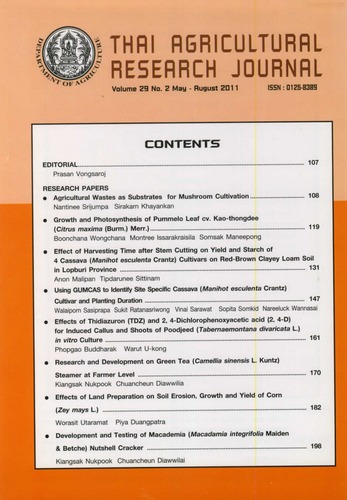Using GUMCAS to Identify Site Specific Cassava (Manihot esculenta Crantz) Cultivar and Planting Duration
DOI:
https://doi.org/10.14456/thaidoa-agres.2011.22Keywords:
cassava cultivar, GIS, crop simulation model, site-specific technologyAbstract
Cassava yield is totally depended on various components namely soil, climate, cultivar and management practices. These factors are normally employed to produce the suitable cultivar and optimum planting duration. Using GUMCAS associated with geographic information system to simulated yield of 7 cassava cultivars namely Rayong 5, Rayong 90, Rayong 9, Rayong 11 and Kasetsart 50 as well as weather data during 2545-2551. Soil properties, genetic coefficients and management under rainfed conditions with 52 planting dates; harvested at 12 months after planting under the assumptions were considered without fertilizer assumptions to identify site specific cassava cultivar and planting duration. Interaction of cultivar and environment were studied in order to assess adaptability and stability of each cultivar. Planting duration and cultivar analysis showed less interaction, so analysis should be made separately in each factor. Rayong 5, Rayong 90 and Kasetsart 50 are wide adaptability but moderate yield while Rayong 7, Rayong 9, and Rayong 72 were responsed to appropriate environment. Choosing site specific cultivar was determined by attainable yield above average of Rayong 5 and eastern region is more choice than other areas.
Downloads
Published
How to Cite
Issue
Section
License
Copyright (c) 2017 วารสารวิชาการเกษตร (Thai Agricultural Research Journal)

This work is licensed under a Creative Commons Attribution-NonCommercial-NoDerivatives 4.0 International License.
Thai Agricultural Research Journal



